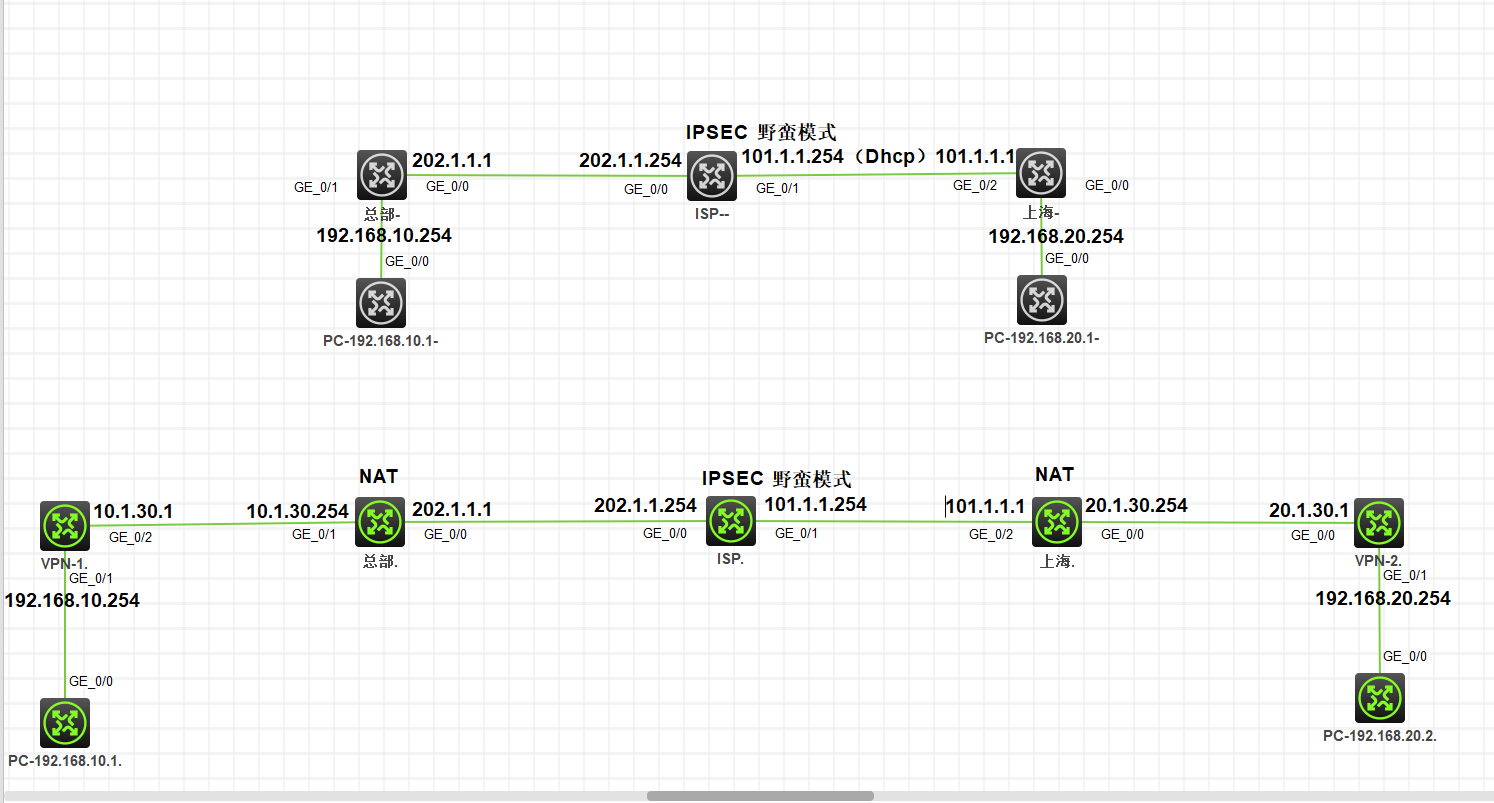有谁知道
- 0关注
- 1收藏,2112浏览
问题描述:
VPN部署在出口,VPN没有问题
VPN部署在内网设备,怎么也不通,不知道问题出在哪里了
总部端DIS IKE SA无任何显示
上海端

组网及组网描述:

- 2021-10-25提问
- 举报
-
(0)
最佳答案

您好,参考这个
3.9.3 IKEv2 NAT穿越典型配置举例
1. 组网需求
Device A在NAT安全网关内网侧。要求在Device A和Device B之间建立一个IPsec隧道,对Host A所在的子网(10.1.1.2/24)与Host B所在的子网(10.1.2.2/24)之间的数据流进行安全保护。具体需要求如下:
· 协商双方使用缺省的IKEv2安全提议和IKEv2安全策略。
· 第一阶段协商的认证方法为预共享密钥认证。
2. 组网图
图3-4 IKEv2 NAT穿越典型组网图

3. 配置步骤
(1) 配置Device A
# 配置各接口的IP地址,具体略。
# 配置ACL 3101,定义要保护由子网10.1.1.0/24去往子网10.1.2.0/24的数据流。
<DeviceA> system-view
[DeviceA] acl advanced 3101
[DeviceA-acl-ipv4-adv-3101] rule 0 permit ip source 10.1.1.0 0.0.0.255 destination 10.1.2.0 0.0.0.255
[DeviceA-acl-ipv4-adv-3101] quit
# 创建IPsec安全提议transform1。
[DeviceA] ipsec transform-set transform1
# 配置采用的安全协议为ESP。
[DeviceA-ipsec-transform-set-transform1] protocol esp
# 配置ESP协议采用的加密算法为3DES,认证算法为HMAC-MD5。
[DeviceA-ipsec-transform-set-transform1] esp encryption-algorithm 3des-cbc
[DeviceA-ipsec-transform-set-transform1] esp authentication-algorithm md5
[DeviceA-ipsec-transform-set-transform1] quit
# 创建IKEv2 keychain,名称为keychain1。
[DeviceA] ikev2 keychain keychain1
# 创建IKEV2对端,名称为peer1。
[DeviceA-ikev2-keychain-keychain1] peer peer1
# 指定对端peer1的主机地址为2.2.2.2/16。
[DeviceA-ikev2-keychain-keychain1-peer-peer1] address 2.2.2.2 16
# 指定对端 peer1 的身份信息。
[DeviceA-ikev2-keychain-keychain1-peer-peer1] identity address 2.2.2.2
# 配置对端peer1使用的预共享密钥为明文123。
[DeviceA-ikev2-keychain-keychain1-peer-peer1] pre-shared-key plaintext 123
[DeviceA-ikev2-keychain-keychain1-peer-peer1] quit
[DeviceA-ikev2-keychain-keychain1] quit
# 创建IKEv2 profile,名称为profile1。
[DeviceA] ikev2 profile profile1
# 指定引用的IKEv2 keychain为keychain1。
[DeviceA-ikev2-profile-profile1] keychain keychain1
# 配置本端身份为FQDN名称***.***。
[DeviceA-ikev2-profile-profile1] identity local fqdn ***.***
# 配置匹配对端身份的规则为IP地址2.2.2.2/16。
[DeviceA-ikev2-profile-profile1] match remote identity address 2.2.2.2 255.255.0.0
[DeviceA-ikev2-profile-profile1] quit
# 创建一条IKEv2协商方式的IPsec安全策略,名称为policy1,顺序号为1。
[DeviceA] ipsec policy policy1 1 isakmp
# 配置IPsec隧道的对端IP地址为2.2.2.2。
[DeviceA-ipsec-policy-isakmp-policy1-1] remote-address 2.2.2.2
# 指定引用的安全提议为transform1。
[DeviceA-ipsec-policy-isakmp-policy1-1] transform-set transform1
# 指定引用ACL 3101。
[DeviceA-ipsec-policy-isakmp-policy1-1] security acl 3101
# 指定引用的IKEv2 profile为profile1。
[DeviceA-ipsec-policy-isakmp-policy1-1] ikev2-profile profile1
[DeviceA-ipsec-policy-isakmp-policy1-1] quit
# 在接口GigabitEthernet2/0/1上应用IPsec安全策略policy1。
[DeviceA] interface gigabitethernet 2/0/1
[DeviceA-GigabitEthernet2/0/1] ipsec apply policy policy1
[DeviceA-GigabitEthernet2/0/1] quit
# 配置到Host B所在子网的静态路由。
[DeviceA] ip route-static 10.1.2.0 255.255.255.0 1.1.1.2
(2) 配置Device B
# 配置各接口的IP地址,具体略。
# 配置ACL 3101,定义要保护由子网10.1.2.0/24去往子网10.1.1.0/24的数据流。
<DeviceB> system-view
[DeviceB] acl advanced 3101
[DeviceB-acl-ipv4-adv-3101] rule 0 permit ip source 10.1.2.0 0.0.0.255 destination 10.1.1.0 0.0.0.255
[DeviceB-acl-ipv4-adv-3101] quit
# 创建IPsec安全提议transform1。
[DeviceB] ipsec transform-set transform1
# 配置采用的安全协议为ESP。
[DeviceB-ipsec-transform-set-transform1] protocol esp
# 配置ESP协议采用的加密算法为3DES,认证算法为HMAC-MD5。
[DeviceB-ipsec-transform-set-transform1] esp encryption-algorithm 3des-cbc
[DeviceB-ipsec-transform-set-transform1] esp authentication-algorithm md5
[DeviceB-ipsec-transform-set-transform1] quit
# 创建IKEv2 keychain,名称为keychain1。
[DeviceB]ikev2 keychain keychain1
# 创建IKEV2对端,名称为peer1。
[DeviceB-ikev2-keychain-keychain1] peer peer1
# 指定对端 peer1 的主机地址为1.1.1.1/16。
[DeviceB-ikev2-keychain-keychain1-peer-peer1] address 1.1.1.1 16
# 指定对端 peer1的身份信息。
[DeviceB-ikev2-keychain-keychain1-peer-peer1] identity address 1.1.1.1
# 配置对端peer1使用的预共享密钥为明文123。
[DeviceB-ikev2-keychain-keychain1-peer-peer1] pre-shared-key plaintext 123
[DeviceB-ikev2-keychain-keychain1-peer-peer1] quit
[DeviceB-ikev2-keychain-keychain1] quit
# 创建IKEv2 profile,名称为profile1。
[DeviceB] ikev2 profile profile1
# 指定引用的IKEv2 keychain为keychain1。
[DeviceB-ikev2-profile-profile1] keychain keychain1
# 配置匹配对端身份的规则为FQDN名称***.***。
[DeviceB-ikev2-profile-profile1] match remote identity fqdn ***.***
[DeviceB-ikev2-profile-profile1] quit
# 创建一个IKEv2协商方式的IPsec安全策略模板,名称为template1,顺序号为1。
[DeviceB] ipsec policy-template template1 1
# 配置IPsec隧道的对端IP地址为1.1.1.1。
[DeviceB-ipsec-policy-template-template1-1] remote-address 1.1.1.1
# 指定引用ACL 3101。
[DeviceB-ipsec-policy-template-template1-1] security acl 3101
# 指定引用的安全提议为transform1。
[DeviceB-ipsec-policy-template-template1-1] transform-set transform1
# 指定引用的IKEv2 profile为profile1。
[DeviceB-ipsec-policy-template-template1-1] ikev2-profile profile1
[DeviceB-ipsec-policy-template-template1-1] quit
# 引用IPsec安全策略模板创建一条IKEv2协商方式的IPsec安全策略,名称为policy1,顺序号1。
[DeviceB] ipsec policy policy1 1 isakmp template template1
# 在接口GigabitEthernet2/0/1上应用安全策略policy1。
[DeviceB] interface gigabitethernet 2/0/1
[DeviceB-GigabitEthernet2/0/1] ipsec apply policy policy1
[DeviceB-GigabitEthernet2/0/1] quit
# 配置到Host A所在子网的静态路由。2.2.2.1为本例中的直连下一跳地址,实际使用中请以具体组网情况为准。
[DeviceB] ip route-static 10.1.1.0 255.255.255.0 2.2.2.1
4. 验证配置
以上配置完成后,子网10.1.1.0/24若向子网10.1.2.0/24发送报文,将触发IKEv2协商。
# 可通过如下显示信息查看到Device A上IKEv2协商成功后生成的IKEv2 SA。
[DeviceA] display ikev2 sa
Tunnel ID Local Remote Status
---------------------------------------------------------------------------
1 1.1.1.1/500 2.2.2.2/500 EST
Status:
IN-NEGO: Negotiating, EST: Establish, DEL:Deleting
[DeviceA] display ikev2 sa verbose
-----------------------------------------------
Connection ID: 13
Outside VPN:
Inside VPN:
Profile: profile1
Transmitting entity: Initiator
-----------------------------------------------
Local IP: 1.1.1.1
Local ID type: FQDN
Local ID: ***.***
Remote IP: 2.2.2.2
Remote ID type: IPV4_ADDR
Remote ID: 2.2.2.2
Authentication-method: PRE-SHARED-KEY
Authentication-algorithm: MD5
Encryption-algorithm: 3DES-CBC
Life duration(sec): 86400
Remaining key duration(sec): 84565
Exchange-mode: Aggressive
Diffie-Hellman group: Group 1
NAT traversal: Detected
# 可通过如下显示信息查看到IKEv2协商生成的IPsec SA。
[DeviceA] display ipsec sa
-------------------------------
Interface: GigabitEthernet2/0/1
-------------------------------
-----------------------------
IPsec policy: policy1
Sequence number: 1
Mode: ISAKMP
-----------------------------
Tunnel id: 0
Encapsulation mode: tunnel
Perfect forward secrecy:
Path MTU: 1435
Tunnel:
local address: 1.1.1.1
remote address: 2.2.2.2
Flow:
sour addr: 10.1.1.0/255.255.255.0 port: 0 protocol: IP
dest addr: 10.2.1.0/255.255.255.0 port: 0 protocol: IP
[Inbound ESP SAs]
SPI: 830667426 (0x3182faa2)
Transform set: ESP-ENCRYPT-3DES-CBC ESP-AUTH-MD5
SA duration (kilobytes/sec): 1843200/3600
SA remaining duration (kilobytes/sec): 1843200/2313
Max received sequence-number:
Anti-replay check enable: Y
Anti-replay window size: 64
UDP encapsulation used for nat traversal: Y
Status: active
[Outbound ESP SAs]
SPI: 3516214669 (0xd1952d8d)
Transform set: ESP-ENCRYPT-3DES-CBC ESP-AUTH-MD5
SA duration (kilobytes/sec): 1843200/3600
SA remaining duration (kilobytes/sec): 1843200/2313
Max received sequence-number:
Anti-replay check enable: Y
Anti-replay window size: 64
UDP encapsulation used for nat traversal: Y
Status: active
3.10 常见错误配置举例
3.10.1 IKEv2提议不匹配导致IKEv2 SA协商失败
1. 故障现象
通过如下命令查看当前的IKEv2 SA信息,发现IKEv2 SA的状态(Status字段)为IN-NEGO。
<Sysname> display ikev2 sa
Tunnel ID Local Remote Status
---------------------------------------------------------------------------
5 123.234.234.124/500 123.234.234.123/500 IN-NEGO
Status:
IN-NEGO: Negotiating, EST: Establish, DEL:Deleting
2. 故障分析
IKEv2提议配置错误。
3. 处理过程
(1) 排查IKEv2相关配置。具体包括:检查两端的IKEv2提议是否匹配,即IKEv2提议中的认证方法、认证算法、加密算法、PRF算法是否匹配。
(2) 修改IKEv2提议的配置,使本端IKEv2提议的配置和对端匹配。
3.10.2 IPsec提议不匹配导致IPsec SA协商失败
1. 故障现象
通过display ikev2 sa命令查看当前的IKEv2 SA信息,发现IKEv2 SA协商成功,其状态(Status字段)为EST。但通过display ipsec sa命令查看当前的IPsec SA时,发现没有协商出相应的IPsec SA。
2. 故障分析
IPsec安全策略参数配置错误。
3. 处理过程
(1) 排查IPsec相关配置。具体包括:检查双方接口上应用的IPsec安全策略的参数是否匹配,即引用的IPsec安全提议的协议、加密算法和认证算法是否匹配。
(2) 修改IPsec策略配置,使本端IPsec安全策略的配置和对端匹配。
3.10.3 无法建立安全隧道
1. 故障现象
双方的ACL配置正确,也有相匹配的IKEv2安全提议,但安全隧道无法建立或者存在安全隧道却无法通信。
2. 故障分析
这种情况一般是由于网络状态不稳定,安全隧道建立好以后,有一方的设备重启造成了两端的IKEv2 SA或者IPsec SA不对称。
3. 处理过程
使用display ikev2 sa命令检查双方是否都已建立IKEv2 SA。如果有一端存在的IKEv2 SA在另一端上不存在,请先使用reset ikev2 sa命令清除双方不对称存在的IKEv2 SA,并重新发起协商;如果两端存在对称的IKEv2 SA,则使用display ipsec sa命令查看接口上的安全策略是否已建立了对称的IPsec SA。如果一端存在的IPsec SA在另一端上不存在,请使用reset ipsec sa命令清除双方不对称存在的IPsec SA,并重新发起协商。
- 2021-10-25回答
- 评论(0)
- 举报
-
(0)


亲~登录后才可以操作哦!
确定你的邮箱还未认证,请认证邮箱或绑定手机后进行当前操作
举报
×
侵犯我的权益
×
侵犯了我企业的权益
×
- 1. 您举报的内容是什么?(请在邮件中列出您举报的内容和链接地址)
- 2. 您是谁?(身份证明材料,可以是身份证或护照等证件)
- 3. 是哪家企业?(营业执照,单位登记证明等证件)
- 4. 您与该企业的关系是?(您是企业法人或被授权人,需提供企业委托授权书)
抄袭了我的内容
×
原文链接或出处
诽谤我
×
- 1. 您举报的内容以及侵犯了您什么权益?(请在邮件中列出您举报的内容、链接地址,并给出简短的说明)
- 2. 您是谁?(身份证明材料,可以是身份证或护照等证件)
对根叔社区有害的内容
×
不规范转载
×
举报说明


暂无评论